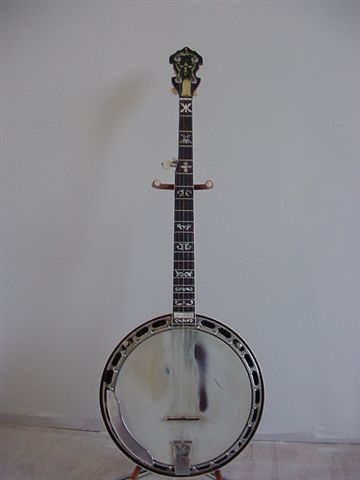
Recently, I was asked by Don
Wayne Reno to oversee a restoration on his fatherís 1935 Gibson RB-3 Mastertone
banjo. This instrument (serial # 518-1) was owned and used by Earl Scruggs as a
member of Bill Monroeís Bluegrass Boys during the early days of the birth of
Bluegrass music. Earl Scruggs continued playing this banjo into the beginning
years of the Foggy Mountain Boys with Lester Flatt. Earl Scruggs later traded
the banjo to Don Reno, and Don used this banjo throughout his career. The banjo
was passed on to Donís son, Don Wayne Reno, another great banjoist who continues
to be inspired by this sensational instrument.
This instrument was owned and used by the two first
generation Masters, who gave to Bluegrass music, the essential element for its
own unique sound. This banjo has been in service since 1946. The history of this
banjo is unparalleled, and has, ahead of all the others; help make the Gibson
Mastertone banjo the industry standard for Bluegrass and Country Music.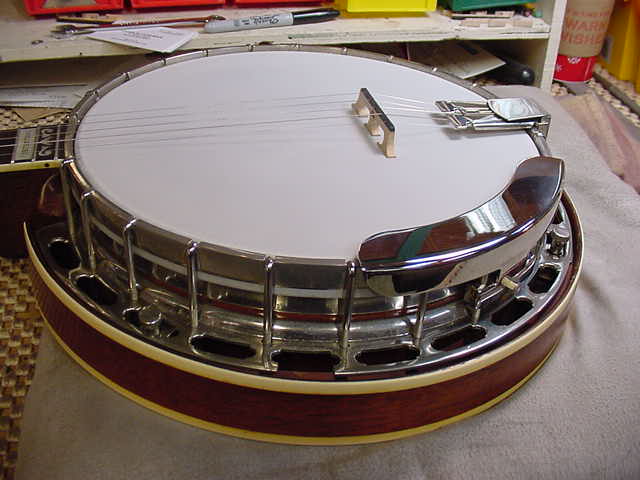
I started the restoration with a detailed photo session of
the banjo in its condition upon arrival, and continued the photographs
throughout the restoration. I was assisted by some of the talented men who work
at the Gibson banjo factory in Nashville. They were all eager to
contribute their time, thoughts, and talents to this project. We were all
honored to participate in this restoration.
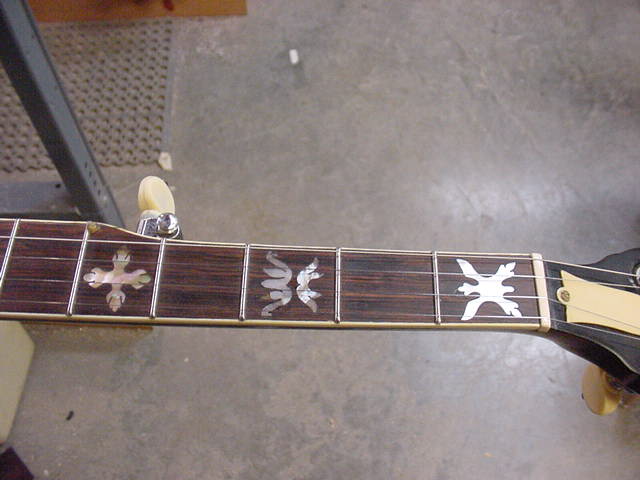 I removed the neck and coordinator rods from the pot
assembly. The pot was dis-assembled, and non-original parts were set aside to
return to Don Wayne. If you observe some of the photos of Don Reno with this
banjo, you can see that he would occasionally change some of the parts. He used
different armrests, tailpieces, and tuners. Upon arrival, the banjo had chrome
hooks and nuts that were not Gibson parts, and some wood screws holding the "L"
brackets in place that were not original. The original tailpiece and armrest
were also missing. Other than these parts and a new nut and geared 5th
string peg, this banjo is original.
I removed the neck and coordinator rods from the pot
assembly. The pot was dis-assembled, and non-original parts were set aside to
return to Don Wayne. If you observe some of the photos of Don Reno with this
banjo, you can see that he would occasionally change some of the parts. He used
different armrests, tailpieces, and tuners. Upon arrival, the banjo had chrome
hooks and nuts that were not Gibson parts, and some wood screws holding the "L"
brackets in place that were not original. The original tailpiece and armrest
were also missing. Other than these parts and a new nut and geared 5th
string peg, this banjo is original.
I carefully cleaned all the metal parts and the outside of
the rim under the flange. I left the inside of the rim with the Mastertone
Guarantee label as it was. My mind raced with thoughts of the classic sounds
that were created through this very sacred combination of wood and metal! The
"L" brackets were bent down from years of use, so I straightened them back to
the correct angle, and used the remaining original screws to attach them back to
the rim. The original coordinator rods and washers and nuts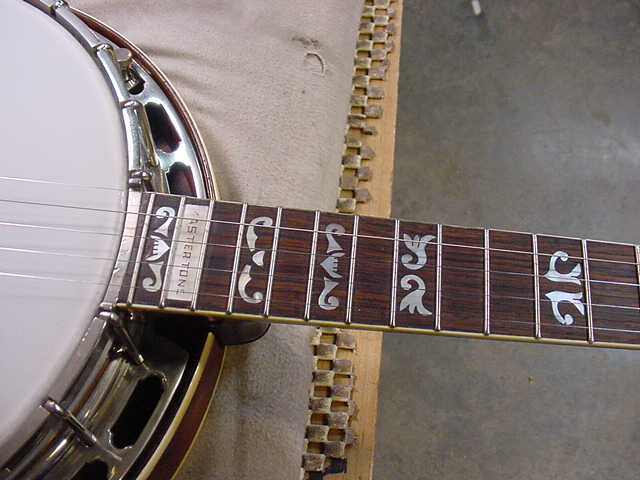 were all in good
condition. The flange was not removed from the rim. A missing section on the
upper part of the flange reminded me of how fragile the pot metal material is.
The break in the flange happened (I was told) when the banjo fell (in itsí case)
from a bunk in the Reno and Harrell bus. This missing section is an identifying
character that can be seen in many photos of Don and his banjo. I found a nice
even coated Remo head, and re-assembled the pot using the proper parts.
Reproduction hooks and nuts, Presto tailpiece, and Pre-War style armrest were
used. The pot was tuned and set aside until the neck restoration was completed.
were all in good
condition. The flange was not removed from the rim. A missing section on the
upper part of the flange reminded me of how fragile the pot metal material is.
The break in the flange happened (I was told) when the banjo fell (in itsí case)
from a bunk in the Reno and Harrell bus. This missing section is an identifying
character that can be seen in many photos of Don and his banjo. I found a nice
even coated Remo head, and re-assembled the pot using the proper parts.
Reproduction hooks and nuts, Presto tailpiece, and Pre-War style armrest were
used. The pot was tuned and set aside until the neck restoration was completed.
The resonator of this banjo is unique to typical Gibson
Pre-War specs, as the inner lining is made of
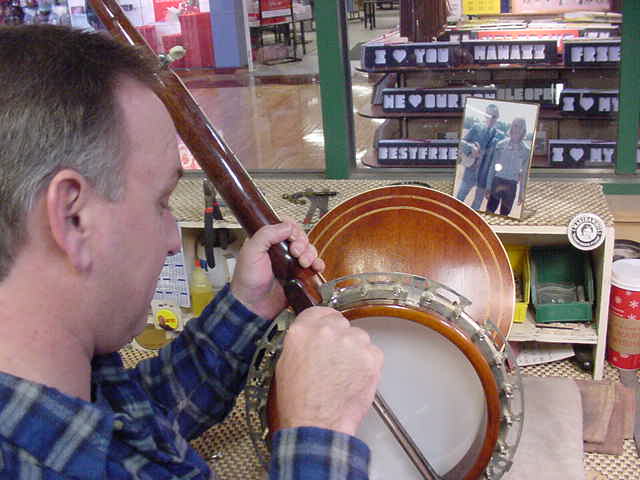 maple instead of the usual poplar
lining. I have occasionally seen this on a few other Pre-War Gibson banjos. The
resonator on this banjo is bound as a style 3. Some folks have called this banjo
an RB-75 by serial designation, but the resonator denotes style 3. The resonator
has had the finish worn off and re-touched. Don Reno has also signed his name on
the inside of the resonator, and carved his name in the back of the resonator
near the heel slot. No doubt about the history of this wonderful banjo. The
resonator is structurally sound and complete with the original wall lugs and
mounting screws
maple instead of the usual poplar
lining. I have occasionally seen this on a few other Pre-War Gibson banjos. The
resonator on this banjo is bound as a style 3. Some folks have called this banjo
an RB-75 by serial designation, but the resonator denotes style 3. The resonator
has had the finish worn off and re-touched. Don Reno has also signed his name on
the inside of the resonator, and carved his name in the back of the resonator
near the heel slot. No doubt about the history of this wonderful banjo. The
resonator is structurally sound and complete with the original wall lugs and
mounting screws
The original 5 string neck of this banjo had obviously seen a
lot of wear in itsí 60+ years of service. The many hours of playing by Earl,
Don, and Don Wayne, along with the many repairs through the years, made the
restoration of the neck and fingerboard the most critical and delicate part of
this project. The banjo has been re-fretted many times since new, and the
Brazilian rosewood fingerboard worn to great degrees. Upon inspection, the worn
areas of the fingerboard had been filled and covered with varnish to slow
further wear. The frets had been filed nearly flat to the fingerboard and left
un-crowned. The banjo would not make a clear note sound on virtually any fret
when Don Wayne left it with me.
Gibsonís Ed Weber removed the old frets, planed the
fingerboard, filled the grooves, and final glass planed the board before
installing all new frets and a new nut. The original Mastertone block was
carefully ejected from the fingerboard to avoid breakage. The beautifully
figured rosewood fingerboard has now been restored to 98% of its original
condition! Ed also repaired some of the pearl inlay that was flaking and falling
out due to continuous use. We found part of an old matchbook under the nut that
was used as a shim from a former repair. Please visit Edís website
www.customscrimshaw.com and
see more of Edís talents.
Through many years of use and changing of the tuning pegs,
the original tuner holes in the headstock had become enlarged and nearly "oval"
shaped. The banjo had oversized washers on the face of the headstock to hold the
tuners in when Don Wayne brought the banjo to me. Gibson luthier Jackie Miller
put dowels in the enlarged headstock holes and re-drilled the headstock to
accept the original style Grover pancake tuners. The banjo will now stay in
tune.
Gibsonís Tony Wray contributed to the restoration by shaping
and cutting the string slots on the new nut, and crowning and dressing the new
frets. Tonyís care and expertise made this old banjo "play like butter" as we
say.
Gibson machinist Jon Lovette assumed the task of
re-installing the original 5th string guide nut into the fingerboard.
A delicate operation it was, as the 5th fret required the routing of
a half circle to set the nut. Jon makes the resonators for all the new Gibson
banjos.
After restoring the neck, re-building the pot assembly, and
completing the missing parts, I re-assembled the banjo. With the original neck
fit from the Kalamazoo factory, the neck resumed proper pitch, and I selected
the appropriate new Gibson 5/8" bridge. The banjo had received a long over due
restoration.
This banjo absolutely "roared" when I tuned it up and all the
guyís at Gibson did too!!! This was an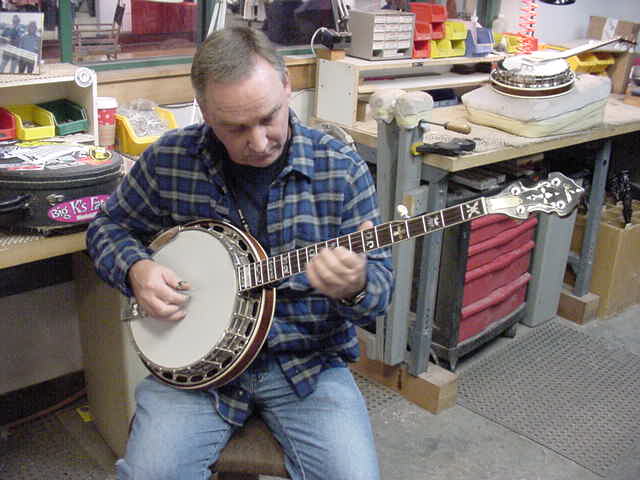 extremely satisfying moment for all of
us!!! I called Don Wayne to let him know of our progress, and to ask for some
extra time for me to do an extensive set-up. He agreed, and was very pleased
about our results.
extremely satisfying moment for all of
us!!! I called Don Wayne to let him know of our progress, and to ask for some
extra time for me to do an extensive set-up. He agreed, and was very pleased
about our results.
Then came the best part for me. Iíve been a Reno and Smiley
fan since I was 12 years old, and I have all of Donís recordings. I became a fan
of Earl Scruggs at the age of 4, and I have all of his recordings. Earl Scruggs
banjo playing is what first inspired me to play the banjo. I have all the 78-RPM
records of the Bluegrass Boys with Lester and Earl. I have studied all of these
collections of recorded output greatly during my 38 years of playing the banjo.
I selected some of my favorite cutís that came to mind, pulled the albums, 45ís
and 78ís and started listening to the many great performances that were recorded
on this banjo. From those inspirations, I started the set-up of this incredible
instrument.
Well, it didnít take long for me to retrieve the sound I had
imagined to come from this banjo. I believe an exceptional instrument will
remain, and just get better with use and proper maintenance. The sound so many
of us banjo players know and love, still lives through this great instrument.
This banjo "vibrates" like no other banjo that Iíve ever played and has a sound
"all itsí own". It was an incredible experience, exploring the potentials of
this banjo.
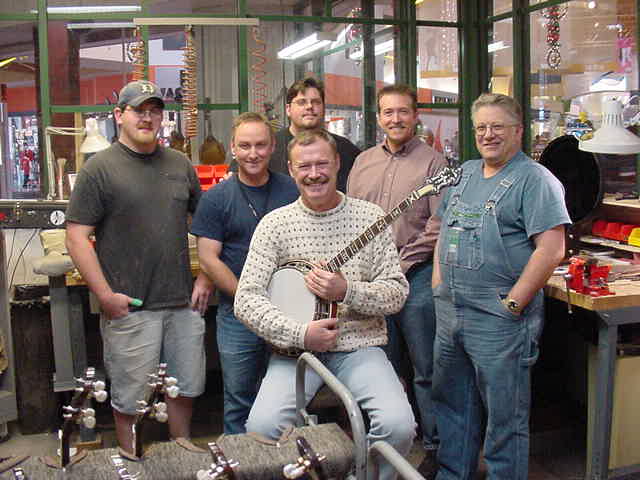 Don Wayne came to the factory to pick up the banjo, and
expressed his thanks and gratitude to all of us. He offered to let me use the
banjo whenever I wanted, and I have taken him up on the offer many times. I have
used the banjo to record several very special new projects here in Nashville
that will be released in 2006! I feel I can speak for my friends at Gibson by
saying, "Thanks Don Wayne, for allowing us the privilege to help maintain one of
our Bluegrass and American Music treasures. The 1935 Gibson RB-3 Mastertone
Banjo, also known as "Nellie". We are all truly blessed".
Don Wayne came to the factory to pick up the banjo, and
expressed his thanks and gratitude to all of us. He offered to let me use the
banjo whenever I wanted, and I have taken him up on the offer many times. I have
used the banjo to record several very special new projects here in Nashville
that will be released in 2006! I feel I can speak for my friends at Gibson by
saying, "Thanks Don Wayne, for allowing us the privilege to help maintain one of
our Bluegrass and American Music treasures. The 1935 Gibson RB-3 Mastertone
Banjo, also known as "Nellie". We are all truly blessed".
Charlie Cushman
